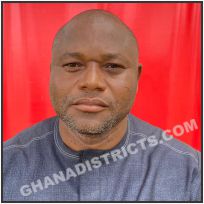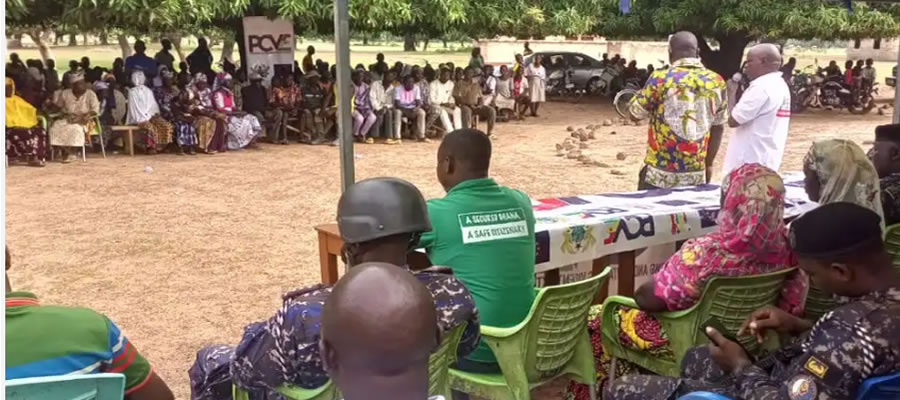

PHYSICAL AND NATURAL ENVIRONMENT
Location and land size
The District is located in the South Eastern corner of the Upper East Region of the Republic of Ghana. It shares boundaries with, Bawku Municipal to the North, Binduri to the North West, Pusiga District to North East, East Mamprusi District to the South West, Bunkpurugu-Yunyoo District to South East, Bawku West District to the West and the Republic of Togo to the East.
It covers an area of 1,230 Km2. It lies on approximately latitude 10o 38lN and110N and longitude 0o 06l E and 00 23l E.
The location of the District makes it easy for inter-District, Inter-Regional and International Trade between the Republic of Togo and Northern Region of Ghana. The advantage of the District location is its access to Togo and Northern Region. Easy trade between the people of Togo and Northern Region and our traders results in relative cheaper imported goods and services such as mobile phones, satellite dish and accessories, motor bikes, cloths and animals such as cattles, sheep and goats. Traders in Garu Attends Gusheigu market in the Northern Region and supply the District with relatively cheaper farm produce such as yam and cereals.
The location of the District puts it at advantage as well as disadvantage in position. It is far remote from the Regional and other District Capitals in the Region. It costs money and time to transact business at the Regional level. The fact that it shares boundaries with Togo results in cross-border crime and other social vices. This can make prevention of HIV/AIDS difficult in the District.
Currently the inter districts and international road network is very poor. Fortunately the Eastern corridor road is to pass through the District and that would further boost trade between the District and Southern sector. It is anticipated that when the road is constructed it would increase our internally generated funds (IGF) and also boost the transport business in the District.
The District shall collaborate with other 6 neighbouring districts and Republic of Togo to improve on the inter districts and international roads to ensure free movement of goods and services.
Relief and Drainage
The District forms an extension of the Gambaga scarp and is underlain mainly by Birrimian and granite rock formations separated in parts by thinly to moderately bedded sandstones. The relief of the District easily marks the highest point of the Upper East Region. In areas bordering the White Volta and its tributaries the relief is generally low and slightly undulating with heights of 120-150 metres above sea level. The rest of the District consists of a series of plateau surfaces. The average height of the plateau is 400 metres above sea level, but isolated peaks rise beyond 430 metres. Being relatively flat, the area supports Agricultural Development. Mechanized agriculture using tractors and bullock ploughs is therefore common.
The White Volta and its tributaries, the most significant of which is the Tamne, drain the District. The others are Pawnaba-Kiyinchongo streams. These rivers have strong irregular seasonal flow patterns. They flow from June to December with peaks in August and September. During the wet season they flow excessively followed by recession and low water levels during off seasons. This water supports onion, water melon and vegetable cultivation in the dry season.
Except in a few areas around the river basins where the drainage becomes poor because of seasonal flooding, the area is generally well drained. This provides a suitable environment for both agricultural development and human settlement. One major challenge affecting these rivers is siltation resulting from cultivation along the banks. Public education against this practice and planting of trees along could help sustain the life of the rivers.
Climate
Garu-Tempane is part of the interior continental climatic zone of the country characterised by pronounced dry and wet seasons. The two seasons are influenced by two alternate air masses. One of them is the cold, dusty and dry harmatan air or the North East trade winds which blows mostly from late November to early March in the North-Easterly direction.
During that period rainfall is entirely absent and humidity is very low, sometimes less than 10mm and relative humidity rarely exceeds 20% during the day but may rise up to 60% during the night and early morning. Temperature is usually modest at this time of the year by tropical standards (260-280 C). Between March and May temperatures could be as high as 380C.
The highest mean monthly temperature is 400C, which occurs in April while the lowest temperature of 180C occurs in December/January. There is plenty sun shine in the area which can support solar energy development. There are also potentials for wind mills which can be used for irrigation purposes. The period is characterised by such human and animal diseases such as CSM, Anthrax, and Newcastle etc.
The second air mass occurs between May and October. During this period the area comes under the influence of the deep tropical maritime air mass. The air mass, together with rising convection currents, provides the District with its rains. Total rainfall amounts average 800mm per annum.
During this period the rainfall is torrential, unpredictable and unreliable. The large quantity of rain water is normally lost through evaporate-transpiration from open surfaces partly due to the bare and dry nature of the ground. This affects availability of water for agriculture and domestic consumption. It is estimated that a volume of between 1.55 to 1.65 cubic metres per square area of the rainfall is lost per annum. It is this rain which supports the on season cultivation of the major food and cash crops in the District. There is therefore a large potential for water harvesting for agriculture and livestock rearing.
Vegetation.
The vegetation is mainly of the Sahel savannah type, consisting of open savannah with fire swept grassland separating deciduous trees among which can be seen a few broad-leaved species. The most densely vegetated forest reserves include, Denugu, Siisi, Kpatua, Nakinting, Kariyata and Wakpesi. Other isolated places are Karateshie and Tarvago forest reserves.
This Vegetation supports livestock development in the area. It also contains some economic trees like shea nut and dawadawa which support livelihoods in the area. There are also some medicinal plants. A cursory look at the vegetation portrays on uncontrolled destruction of the environment for livelihood activities. The effects of this is that uncontrolled destruction of some of these trees are gradually fading out, this affects livestock, livelihood production and the destruction of biodiversity. There would be the need to revive community environmental committees or other community action groups to see to the rejuvenation of the vegetation cover.
Geology
The oldest rocks of the North-Eastern part of Ghana are those of the pre-Cambrian basement complex. The basement is made up of granite, exposed over the Western and Northern parts of the District as tabular hills.
Hydrology
In the basement complex, ground water is found in weathered mantle in abundant quantities. The quality of ground water from the basement complex makes it ideally suitable for drinking and irrigation purposes. It is therefore not difficult drilling boreholes and constructing dams in the area.
Soil
The District is covered with three main soil types:
Red and brown Sandy loam and clays associated with horn blended granular.
Moderately deep, pale brown coarse sandy loams associated with biotitic granites.
Gray sandy loams and clays in river valleys.
These support a variety of crop production in the District, mainly cereals and Legumes and can also support brick and tile and pottery industries.
Minerals
There are limestone deposits in the Western part of the District notably in the Worikambo Area. This could be exploited for the manufacture of paint and chalk. There are also clear signs of diamond deposits.
Date Created : 11/20/2017 6:22:22 AM











 facebook
facebook
 twitter
twitter
 Youtube
Youtube
 +233 593 831 280
+233 593 831 280 0800 430 430
0800 430 430 GPS: GE-231-4383
GPS: GE-231-4383 info@ghanadistricts.com
info@ghanadistricts.com Box GP1044, Accra, Ghana
Box GP1044, Accra, Ghana